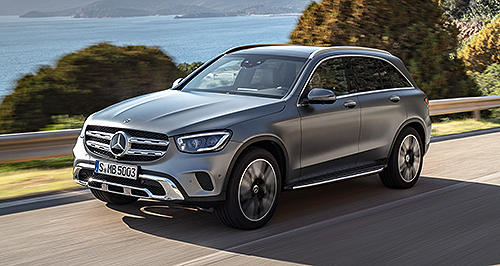Make / Model Search
News - Mercedes-BenzPerfect storm curbs Mercedes sales this yearComeback: The GLC will receive a facelift from October, headlined by the deletion of diesel variants, while a plug-in hybrid version will go on sale next year. Sales weak due to external influences but Mercedes-Benz sees brighter 2020 aheadGallery Click to see larger images 14 Oct 2019 By NEIL DOWLING QUARANTINES of vehicles for possible contamination, delays in overseas fuel testing procedures and a variety of model changes have thwarted Mercedes-Benz Cars sales in Australia this year amid a weakening new-vehicle market.
This has dampened expectations of a strong end-of-year sales finish but brings optimism for 2020.
Speaking to GoAuto in Tasmania this month at the launch of the Mercedes-AMG A35 hot hatch, Mercedes-Benz Australia/Pacific head of media relations and brand engagement Jerry Stamoulis described 2019 as a “funny year” that has not turned out as planned.
“We are just not sure how we will end the year,” he said.
“It has been a funny year in the market with sales affected by external things we couldn’t control like contamination and fuel test delays."
As GoAuto reported in July, Mercedes-Benz Aust/Pac was expecting a stronger showing in the second half of this year after a 13.2 per cent downturn in the first six months of trading, with company chief Horst von Sanden pointing to a range of limiting factors such as local and global political uncertainty, the royal commission into banking, underlying weakness in the housing market.
Mercedes-Benz was also among the brands affected by an infestation of stinkbugs on car shipping carriers that delayed deliveries, as well as challenges abroad relating to diesel homologation and certification issues brought with the switch to WLTP testing rules.
Despite this, Mr von Sanden saw clear skies ahead from mid-2019, but the latest VFACTS figures show Mercedes-Benz Cars has only managed to reduce the year-on-year decline to 9.0 per cent, with 23,644 sales to the end of September – 2338 fewer than at the same point last year.
It remains the clear leader among the prestige brands although BMW has fared better with 18,225 sales in the bank and now trading in the black in year-to-date terms after a solid month in September (+19.4%) that places it 0.1 per cent ahead of where it was at this point last year.
Audi, meanwhile, is struggling with a 25.3 per cent decline so far this year, to 10,922 units, which keeps it in third place. Lexus is next best, enjoying a 6.6 per cent upturn this year to be at 7107 units YTD.
“In the short term this year, based on delays and so on and model cycles, we’re not looking at a big year, but based on what the market is doing we’ll finish better than our competitors,” Mr Stamoulis said.
“There was definitely an opportunity for us to sell more cars, but there were delays that we couldn’t control.
“We call it contamination – stinkbugs and other things – but because there’s heightened quarantine procedures due to the bugs, it affected the delivery of vehicles to shipments.
“WLTP has also slowed us down and caused delays.
“On top of that we are at the seven-year mark where there’s lots of model changeovers. We had GLE and GLC model changes, and the C-Class really only started kicking off this year. The GLA is in run-out and we will see a new model next year.
“It is one of those years that was unpredictable. But we are confident that next year will start seeing some increases in product lifecycle.”
Mr Stamoulis indicated that there will be a change in model mix, starting with dropping the GLC diesel variant and replacing it with a plug-in hybrid version.
“We have changed some model mix, too,” he said.
“We have announced that we won’t bring in GLC diesel. The diesel market has definitely dropped off. But we will bring in a plug-in hybrid version of the GLC and the pricing is quite sharp at about $2700 premium over the GLC300.”
“The GLC launches next month and the plug-in hybrid will be here in the second quarter of next year. We are not expecting huge volumes, but we still see it as a long-term solution, not a short-term.
“The new GLA is here next year, which is an all-new model. I can’t confirm an AMG 35 version of that, but let’s wait and see.
“There’s a group of buyers in A-Class and GLA that unusually have a 50/50 male and female split. There aren’t many other models that have that.”
One of the other battles Mercedes-Benz Aust/Pac is fighting is the luxury car tax and the recent increased duty on luxury vehicles applied by the state governments of Victoria and Queensland.
“We’re seen as an easy target,” Mr Stamoulis said.
“But it’s not us, it’s the customer that is targeted. We are trying hardest to get the cars to have the sharpest pricing and to look good, but at the moment we can’t do anything about the taxes.”  Read more20th of September 2019  Facelifted Mercedes GLC checks in for dutyDiesel out, plug-in hybrid in as Mercedes confirms details for facelifted GLC SUV4th of September 2019  VFACTS: Vehicle market decline acceleratesAugust sales down 10.1 per cent as new-vehicle decline stretches to 17 months |
Click to shareMercedes-Benz articlesResearch Mercedes-Benz Motor industry news |












Facebook Twitter Instagram